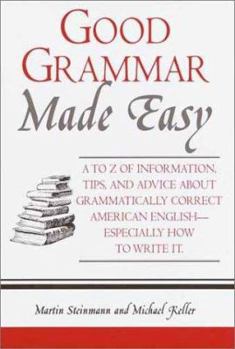Good Grammar Made Easy
For the professional writer, the student working on a paper, or anyone with a question regarding correct grammar, this comprehensive guide, arranged alphabetically, provides all of the answers for... This description may be from another edition of this product.
Format:Hardcover
Language:English
ISBN:0517204975
ISBN13:9780517204979
Release Date:January 2000
Publisher:Gramercy Books
Length:348 Pages
Weight:0.85 lbs.
Dimensions:1.1" x 5.8" x 8.5"
Customer Reviews
1 rating
Pretty good
Published by Thriftbooks.com User , 23 years ago
This book about writing is a practical guide for mostly high school and college students. It is for helping struggling students in high school or college to develop ideas, organize the ideas, improve style, edit, and mastering mechanics. The book is divided into seven subtopics: prewriting, freewriting, rewriting, style, mechanics, formal writing, and conclusion. The book is mostly "how-to write." Thus there is not much philosophy being discussed. In "prewriting," the author emphasizes clustering and outlining. In "freewriting," unhindered writing is advised. In "rewriting," the author stresses organization. In "style," clear and concise words are suggested. "Mechanics" deals with spelling, punctuation, and syntax. "Formal writing" deals thoroughly with applying the above techniques to formality. The writer seems to emphasize following good authors in their techniques - each section begins in a quote from a writer.This particular quote was significant to me: "Take an overall look at what you've clustered. Some of it may not make sense. That's okay. Wisdom has nothing to do with logic." I agree with the author about clustering. One must freely write down everything that comes to mind when prewriting. If one holds something back in the mind, one will not be able to brainstorm well. Clustering is vital.From this book, not only have I absorbed ample concepts that I am not aware of, I have refreshed my memory on some topics I already knew. In "style", Steinmann states that one should form the possessive singular of nouns by adding 's. This shows that a noun is owned by another noun. Placing a comma before a conjunction introducing an independent clause. If there is a comma placed in the middle of a sentence before a word, such as and or but, there are two separate clauses in that sentence. When the comma is reached the second clause has the appearance of an after-thought. One should be careful on the rule because if there is not an and or but then the comma should be a semicolon. Steimann also emphasizes that readers to keep the writing in one tense because the reader may get confused if the writer keeps going to past to present or even future. The author also says that you should place the emphatic words of a sentence at the end. It is necessary because it makes the prominent position more emphatic if it is before the emphatic word.I thought that this book was a very good guide to the "art of writing". It gave many examples and explained every possible subject. It should be greatly useful for teenage students or any budding writer.





